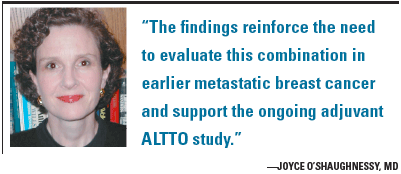Lapatinib Plus Trastuzumab Extends Progression-Free Survival in Women With HER2-Positive Metastatic Breast Cancer
Positive data were reported from the first-ever randomized, multicenter, open-label phase III trial of the combination of two targeted agents, lapatinib (Tykerb) and trastuzumab (Herceptin), in women with HER2-positive metastatic breast cancer. The study results, which were presented at the annual ASCO meeting in Chicago, demonstrated a benefit from the combination (abstract 1015).
ABSTRACT: Total HER2 blockade with lapatinib and trastuzumab may provide achemotherapy-free option for HER2+ metastatic breast cancer.
Positive data were reported from the first-ever randomized, multicenter, open-label phase III trial of the combination of two targeted agents, lapatinib (Tykerb) and trastuzumab (Herceptin), in women with HER2-positive metastatic breast cancer. The study results, which were presented at the annual ASCO meeting in Chicago, demonstrated a benefit from the combination (abstract 1015).
Attacking HER2 From Multiple Angles
Both treatments target the HER2 (ErbB2) protein but work in different ways. Trastuzumab attaches to the outside of the HER2 protein, while lapatinib goes inside the cell to block signals from the HER2 protein for the cancer to grow.
“Many women with HER2 positive breast cancer are still very active and living full lives, yet when their disease progresses after trastuzumab and chemotherapy, we have had limited treatment options. Therefore, it is important to study options that may eventually help women in their fight against this disease,” said lead investigator Joyce O´Shaughnessy, MD, Baylor-Sammons Cancer Center, Texas Oncology, PA, US Oncology, Dallas. “Effectively attacking HER2 from multiple angles is an exciting and innovative approach, and demonstrates the significant advances being achieved in treating this complex form of breast cancer.”

Despite receiving multiple prior lines of anticancer therapy, patients who received lapatinib plus trastuzumab in this study experienced:
• A statistically significant increase in median progression-free survival vs lapatinib alone (12 vs 8.1 weeks).
• A 27% reduction in the risk of disease progression (hazard ratio = 0.73; P = .008).
• A response rate of 10.3% vs 6.9%.
• Double the overall clinical benefit rate vs lapatinib alone (24.7% vs 12.4%; P = .01). Clinical benefit rate is calculated by the response rate and the rate of durable stable disease (≥ 6 months).
• A trend in improved overall survival (hazard ratio = 0.75; P = .106).
The study also demonstrated the activity of lapatinib as a single agent in this patient population, with patients on this arm achieving a median progression free survival of 8.1 weeks and an overall clinical benefit rate of 12.4%.
The clinical synergy of lapatinib and trastuzumab confirms previous observational findings in preclinical studies and previously reported data from a phase I study. These latest findings confirm the rationale for further research of this combination in earlier lines of therapy in the metastatic setting and in early-stage disease. Additional analysis is underway to explore the benefit that lapatinib plus trastuzumab can offer to less heavily pretreated patients.
Study Design and Adverse Events
In this study, 296 patients with HER2-positive breast cancer who had documented progression on trastuzumab treatment in the metastatic setting were eligible to be randomized to receive lapatinib (1,000 mg daily) plus trastuzumab (2 mg/kg weekly after 4 mg/kg loading dose) or lapatinib alone (1,500 mg daily). Patients were heavily pretreated and had received a median of six prior anticancer regimens. Patients had received a median of three prior lines of trastuzumab.
The primary endpoint of the study was progression-free survival, and secondary endpoints included clinical benefit rate (complete response, partial response, or stable disease greater than or equal to 24 weeks), response rate, and overall survival. If patients progressed on the lapatinib monotherapy arm after 4 weeks of therapy, they could cross over to receive the combination of lapatinib plus trastuzumab.
Adverse events were similar in both arms, with grade 1/2 diarrhea higher in the lapatinib-plus-trastuzumab arm (53% vs 41%; P = .03). Two patients in the combination arm and one patient in the lapatinib monotherapy arm experienced symptomatic decreases in left-ventricular ejection fracture (LVEF); one patient in the lapatinib-plus-trastuzumab arm died due to a pulmonary thromboembolism with progressive malignant pleural effusions; two patients with LVEF decrease later recovered. Isolated cases of asymptomatic transient decreases in LVEF were noted in both treatment arms.
